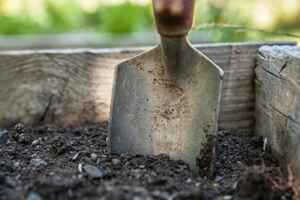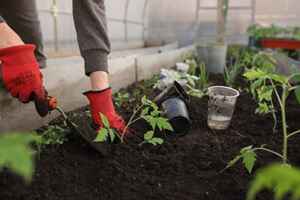Amended Soil: What It Is And How To Make It
Do you have a garden or plan to start one? If so, knowing how to manipulate the soil you use to its highest advantage is important. Not only will the soil you use help your plants grow better, but it can also keep them healthy by preventing disease and insect infestations. One way to do this is by 2making and using amended soil.
So, what is amended soil? Amended soil is just any regular soil that has had other products added to it to increase the nutrients or benefits to the plants that are grown in it. Different additives have different effects so you can mix and match to make the best possible amended soil for your garden.
In this article, we will discuss the different types of amended soil and even give you a few recipes to make your own. Soon enough you’ll have the most beautiful, lush garden on the block and all your neighbors will be asking for your secret.
What Is Amended Soil?
Soil amendment is any process that changes the physical characteristics of soil by adding different products to it. This process makes soils richer in nutrients and more suitable for plant growth.
There are four types of soil amendments: organic materials, mineral supplements, manures, and peat moss. Each type brings unique benefits to your garden’s health which we’ll go over in more detail below.
 Organic Material
Organic Material
Organic material amendments are typically made of plant or animal by-products that have decomposed into compost. These materials are high in nitrogen, phosphorus, and potassium, which plants need for healthy growth.
Using organic materials when amending soil will help you create a better growing environment for your plants to thrive in.
Mineral Supplements
Mineral supplements can be applied to make up for minerals that may be missing from the soil after it has been amended with other products like organic material or manure.
These supplements contain essential nutrients like calcium, magnesium, potassium sulfate, and boron (which helps to prevent diseases related to the vascular system). They also help regulate moisture levels within the soil, preventing drainage issues.
Manures
Manure is a great fertilizer because it contains large amounts of nutrients that are released as the manure breaks down in the soil. It can include animal by-products from plant or animal sources, allowing you to find the best amendment for your garden based on what you have available to you. Manures are an inexpensive amendment and are typically readily available at local feed stores if they are not found in your yard.
Peat Moss
Peat moss is made up of partially decomposed sphagnum moss which has been harvested from bogs around the world. Like other amendments, peat moss helps loosen clay soils while adding organic material to sandy soils, making it easier for plants to grow strong roots. The beneficial fungi in peat moss help protect plants from disease and insect infestations.
Other Terms For Amended Soil
A more scientific term for amended soil is “soil conditioning”. In other words, you are improving your existing soil by adding nutrients and making it easier for plants to take up those nutrients.
An older term used to describe the same process is “topdressing” which references how the top layer of soil was often used as an amendment in farming fields.
Benefits of Amended Soil
Amended soil has many benefits, the first being that it makes planting easier. By adding nutrients to your soil, you are making it possible for seeds and plants to become established quickly rather than slowly because they have to fight against poor quality soil.
When you amend the soil before planting, there is no guesswork involved. The proper amount of fertilizers already added gives seedlings all the nutrients they need to develop strong roots so they aren’t as susceptible to pests or diseases. This allows them to grow larger and produce more vibrant flowers or fruit.
 How To Make Amended Soil
How To Make Amended Soil
There are several techniques for amending soil, but mixing all the amendments is the simplest one. This co-amendment technique works best on small garden plots and raised planters, as it allows you to mix different types of amendments at once.
You can also use this technique to create a custom amendment with ingredients that work best for your specific gardening needs. It is important to note that if you choose to do this, you should not just throw all types of amendments together haphazardly as some may negate the positive effects of others by adding excess amounts of certain minerals or nutrients that alter pH levels.
If You Have Raw Soil
If you have raw soil without any amendments applied already, you will want to start by mixing it with organic material like compost or leaf mold (a type of mulch).
This is especially important with clay soil, as it can be compacted and water will not drain easily. Getting rid of the excess clay in the dirt will allow for proper drainage and airflow between soil particles, which makes it easier for seeds to grow into seedlings with strong root systems.
If You Have Compost
One method of amending soil uses compost as a base with any organic material added on top of the compost. This helps lighten heavy or clay soils and allows them to retain moisture without becoming waterlogged as raw soil does.
Additionally, adding high nitrogen materials like manure or straw to nutrient-rich compost ensures that you won’t lose those nutrients when the plants die back, they’ll be available to your plant’s roots throughout the growing season.
Recipes for Amended Soil
Here are a few basic recipes for amended soil:
The Simple Base Mix Recipe (for raised garden beds and large planters)
- 1 part compost
- ½ part peat moss
- ½ part perlite or vermiculite
This is a quick recipe that allows you to amend your soil in bulk with very little effort. The ratio of compost to peat moss and perlite balances out any deficiencies you may have in your soil. While this recipe works great for planting an entire bed or container, it does not allow you much room to adjust depending on your specific amendment needs as well as picky plant preferences.
 The Control Freak’s Mixed Soil Recipe (for small planters)
The Control Freak’s Mixed Soil Recipe (for small planters)
- ½ part compost
- ½ parts worm castings and leaf mold (this mix has a slightly lower pH than the others)
If you have more time on your hands and want to amend your soil with rich nutrients that promote healthy plants, this recipe is for you. This amendment works well in raised planters or on small garden plots since each product used on its own would be too expensive to add to such a small area.
The Organic Fertilizer Solution Recipe (for raised garden beds)
- 1 part worm castings
- 1 part alfalfa meal
- 1 part kelp meal
The organic fertilizers used in this recipe are perfect for creating nutrient-rich amended soil that can support landscaping around your home once the plants are established.
Amended Soil Recipe Tips
- If you choose to use commercial fertilizers, make sure the ingredients are organic rather than synthetic. The latter contains chemicals that will not break down naturally in your soil and will cause more harm than good. It is best to stick with natural materials like alfalfa meal or cottonseed meal when amending soil.
- When combining amendments, you want to make sure that each amendment has N-P-K ratios that are equal or close together for better nutrient balance in your soil. You can tell what each letter stands for on a fertilizer’s label by using this breakdown:
- Nitrogen (N) promotes plant growth through green foliage and thick stems
- Phosphorus (P) encourages healthy root systems and fruit
- Potassium (K) enhances flower production while strengthening plants against temperature fluctuations, periods of drought, diseases, etc.
- If you are working with clay soil or waterlogged soil, adding perlite to the mixture will make it more porous so that water can drain properly without leaving excess moisture behind.
- Using amendments like alfalfa meal ensures that your plant’s roots have access to the nutrients they need throughout the growing season. Alfalfa meal breaks down slowly but steadily, releasing crucial minerals into the soil over time rather than all at once which helps prevent nutrient burn in sensitive plants like tomatoes.
Are There Any Drawbacks To Amended Soil?
Unfortunately, there are no free lunches. Although amendments can be vital to growing healthy plants without the use of synthetic fertilizers and pesticides, they do come at a cost.
It takes time and effort to amend your soil properly so it is best to stick with amending only areas that will naturally be exposed to high traffic or receive direct sunlight during some part of the day (so plants get enough nutrients).
In Conclusion
Amended soil is a great way to get your garden or landscaping off on the right foot and encourage healthy growth without fertilizers and pesticides.
There are many different recipes for making amended soil out there but you can also make your customized blend with common ingredients like peat moss or alfalfa meal. When choosing amendments for your recipe keep in mind that N-P-K ratios should stay relatively close together and that ingredients like alfalfa meal and worm castings provide nutrients over a longer time.
If you don’t have access to your yard, you can also purchase loamy soil from a local garden center or nursery that has already been amended. This approach may be more expensive than making your amendments but it is fast and easy so it might be the right option for you if you are short on time. Prepare to be the envy of all your neighbors!

